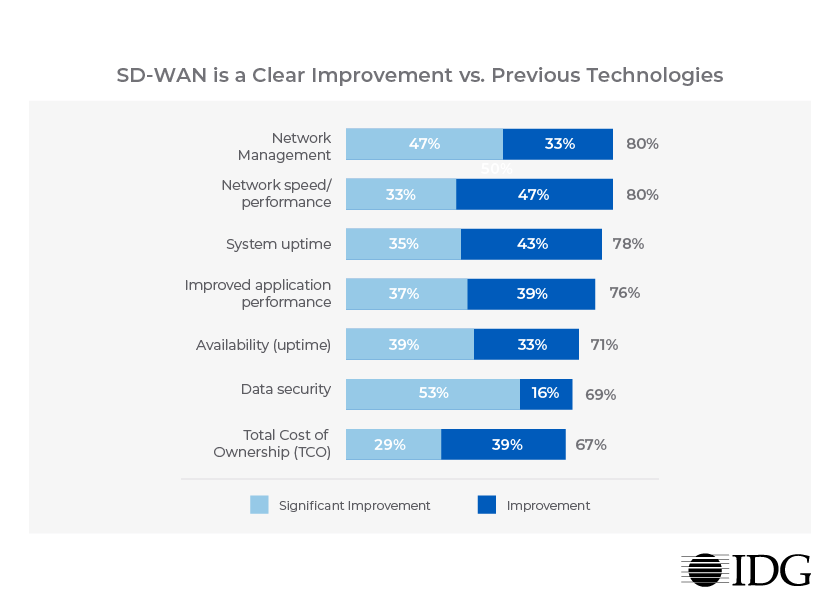Report on Early SD-WAN Implementations & Investment Drivers

Many businesses are hard at work implementing software-defined wide-area networks (SD-WANs) to boost their network performance and data security capabilities. The move to SD-WAN is part of continuing efforts to meet business demands for digital transformation and enhanced customer experiences.
A recent survey conducted by IDG reveals that IT decision-makers at companies that have implemented SD-WAN and/or related ethernet or hybrid WAN technologies reported benefits beyond their expectations. Their experiences can be a guide to those pondering how to put the technology to work in their own organizations.
Key benefits of SD-WAN
The limitations of legacy WANs, such as those based on point-to-point T1 and Multiprotocol Label Switching (MPLS), don’t meet today’s needs for flexibility and cost-effectiveness. They take time to provision and deploy, are limited in bandwidth, and are not designed to accommodate cloud computing when remote offices want to access cloud services directly, without the lag required to communicate via a corporate network hub.
SD-WAN and the related SDN technology are application-driven, rather than bound to physical switches, so organizations can utilize optimum bandwidth and achieve better performance with the most-cost-efficient routing of data. Application-aware routing ensures that enterprises and smaller companies can take advantage of scale, visibility into the network and applications, resilience, and the efficiency of cloud pathways.
A carrier can provide an SDN architecture to customers and dynamically provision virtualized network functions (VNFs), such as SD-WAN and firewalls, onto industry-standard hardware, making deployment speedier, less costly, and easier to manage from a central location. Organizations can also obtain SD-WAN appliances from a growing array of vendors and configure their own software-driven networks, taking advantage of available data channels such as public broadband and wireless.
Exceeding the expectations of early users
IDG surveyed 50 IT decision-makers who have implemented SD-WAN and related ethernet or hybrid WAN technologies to find out how the technology has stacked up to their expectations. More than 80% said time to implement SD-WAN was shorter than what they expected, and another 10% said that it matched their expectations; only a handful are struggling to meet their initial expectations. The survey found that two-thirds accomplished their implementation within six months and that half did so within three months.
Although reduced costs are often the top benefit SD-WAN vendors and service providers tout, the survey respondents indicated that their investments were driven more by network speed and performance, along with data security. When the survey asked the respondents to identify their top three investment priorities, network speed and performance came out on top overall, at 58%, followed by data security (50%) and application performance (40%).
Costs remain a consideration, but as a lower priority. “We went into this four years ago, thinking that we were going to save customers money by going to a more cost-effective solution other than MPLS,” says Jody Hagemann, senior director of SD-WAN product management with Comcast Business. “That has been proven wrong.”
Once they realize what they can do when unrestrained by legacy network limitations, organizations are eager for more and more bandwidth, even if their costs end up equaling or even exceeding what they were previously paying, Hagemann says. “What more you can do with the network has been transformational,” she adds. Typically, once an organization gets the SD-WAN up and running, it wants to know when it can take advantage of additional VNFs such as security.
In fact, when asked to compare how their SD-WAN compares to their previous network in areas such as data security, network management and availability, those citing improvement and significant improvement ranged from a high of 80% to a low of 67%, with most of the other respondents in each area citing either moderate or modest improvement.
Hagemann says her experience with customers backs up that data. “All of our customers have seen improvement in all these areas, some more dramatically than others,” she asserts. “First and foremost is ease of management. Comcast invested in the digital experience so customers can utilize a single pane of glass to manage their network. The streamlining of network management has been a huge bonus to IT managers.”

How to approach SD-WAN
Rapidly growing interest in SD-WAN has spawned a multitude of offerings from entities such as traditional network system vendors, hardware appliance vendors, software developers, managed service providers, and carriers.
Sorting through all the options among vendors and deployment options can be overwhelming. The three primary management options are:
- Self-managed with internal IT staff
- Comanaged with a service provider
- Fully managed by a service provider
Hagemann contends that the first step most organizations should take is to evaluate how much help they will need to get up and running and determine what their connectivity needs are and how much support they will need moving forward. “Many businesses have networks that have been in place for 10 to 15 years, and they really don’t know all of what is on their network,” she says.
Comcast Business Comanaged Solution
Comcast Business offers a comanaged solution, providing the WAN infrastructure and service with its SDN-based ActiveCore platform, along with endpoint SD-WAN appliances and centrally managed VNFs. Comcast customers utilize a unified dashboard for application and network visibility and control across all locations.
This comanaged solution ensures centralized, integrated management of VNFs such as Versa SD-WAN, IP VPN, and routing, so multiple appliances don’t have to be stacked for each function. This empowers businesses to manage their network in real time, reducing network complexity and simplifying WAN management.
For more information on evaluating SD-WAN options and how you can get started, visit https://business.comcast.com/SDN.
A recent survey conducted by IDG reveals that IT decision-makers at companies that have implemented SD-WAN and/or related ethernet or hybrid WAN technologies reported benefits beyond their expectations.
Locked Content
Click on the button below to get access
Unlock NowOr sign in to access all content on Comcast Business Community
Learn how Comcast Business can help
keep you ready for what's next.











